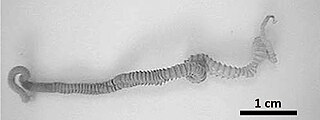
Sand dollars are species of flat, burrowing sea urchins belonging to the order Clypeasteroida. Some species within the order, not quite as flat, are known as sea biscuits. Sand dollars can also be called "sand cakes" or "cake urchins".

The silky anteater, also known as the pygmy anteater, has traditionally been considered a single species of anteater, Cyclopes didactylus, in the genus Cyclopes, the only living genus in the family Cyclopedidae. Found in southern Mexico, and Central and South America, it is the smallest of all known anteaters. It has nocturnal habits and appears to be completely arboreal; its hind feet are highly modified for climbing.

The brown four-eyed opossum is a pouchless marsupial of the family Didelphidae. It is found in different forested habitats of Central and South America, from Nicaragua to Brazil and northern Argentina, including southeastern Colombia, Paraguay and eastern Peru and Bolivia, at elevations from sea level to 1,500 m (4,900 ft). It is the only recognized species in the genus Metachirus, but molecular phylogenetics studies suggest that it should probably be split into several species. Population densities are usually low, and it is uncommon in parts of Central America. A density of 25.6/km2 (66/sq mi) was reported near Manaus, Brazil. Its karyotype has 2n = 14 and FN = 24.
Archiacanthocephala is a class within the phylum of Acanthocephala. They are parasitic worms that attach themselves to the intestinal wall of terrestrial vertebrates, including humans. They are characterised by the body wall and the lemnisci, which have nuclei that divide without spindle formation, or the appearance of chromosomes, or it has a few amoebae-like giant nuclei. Typically, there are eight separate cement glands in the male, which is one of the few ways to distinguish the dorsal and ventral sides of these organisms.
Marasmius tenuissimus is a species of agaric fungus in the large agaric genus Marasmius.

Euryops is a genus of flowering plants in the sunflower family. They are native mostly to rocky sites in southern Africa, with a few species in other parts of Africa and on the Arabian Peninsula. They produce daisy-like flowerheads from fern-like foliage. The name Euryops is probably a contraction of the Greek words ευρυς meaning 'wide,' and ὄψις meaning 'eye,' possibly referring to the large flowerheads compared to the narrow leaves.

Inonotus is a genus of fungi in the family Hymenochaetaceae. The genus, described by Petter Karsten in 1879, is estimated to contain about 80 species sensu lato and 30 species sensu stricto.
Neoechinodiscus is a genus of two species of lichenicolous fungi with uncertain familial placement in the order Helotiales.

Gigantorhynchus is a genus of Acanthocephala that parasitize marsupials, anteaters, and possibly baboons by attaching themselves to the intestines using their hook-covered proboscis. Their life cycle includes an egg stage found in host feces, a cystacanth (larval) stage in an intermediate host such as termites, and an adult stage where cystacanths mature in the intestines of the host. This genus is characterized by a cylindrical proboscis with a crown of robust hooks at the apex followed by numerous small hooks on the rest of the proboscis, a long body with pseudosegmentation, filiform lemnisci, and ellipsoid testes. The largest known specimen is the female G. ortizi with a length of around 240 millimetres (9.4 in) and a width of 2 millimetres (0.08 in). Genetic analysis on one species of Gigantorhynchus places it with the related genus Mediorhynchus in the family Gigantorhynchidae. Six species in this genus are distributed across Central and South America and possibly Zimbabwe. Infestation by a Gigantorhynchus species may cause partial obstructions of the intestines, severe lesions of the intestinal wall, and may lead to death.

Bulimulus tenuissimus is a species of tropical air-breathing land snail, a pulmonate gastropod mollusk in the subfamily Bulimulinae.
Hypermastus ryukeunsis is a species of sea snail, a marine gastropod mollusk in the family Eulimidae.

Indolestes tenuissimus is a species of damselfly in the family Lestidae, commonly known as the slender reedling. It is found in north-eastern Australia, New Guinea and on Aru.

Imantodes tenuissimus, commonly known as the Yucatán blunthead snake, is a species of snake of the family Colubridae.
Nixon-Skinner Conservation Park is a protected area located in the Australian state of South Australia in the locality of Myponga about 55 kilometres (34 mi) south of the state capital of Adelaide and about 3.5 kilometres (2.2 mi) south-west of the town of Myponga.
Lophiocarpus is a genus of flowering plants belonging to the family Lophiocarpaceae.

Astriclypeidae is a family of echinoderms belonging to the order Clypeasteroida.
Neoechinodiscus kozhevnikovii is a species of lichenicolous (lichen-eating) fungus in the order Helotiales. It is known to occur in Russia, Austria, and Switzerland, where it grows parasitically on lichens in genus Cetraria.

Echinodiscus is a genus of sand dollars within the family Astriclypeidae. There are currently 14 species assigned to the genus, with a majority being extinct.

Echinodiscus bisperforatus is a species of sand dollar described by Nathanael Gottfried Leske in 1778. The species is found throughout the Indo-Pacific in the Red Sea and off the coasts of south and east South Africa, Thailand, Malayan Archipelago, and New Caledonia at depths up to 20 meters. It grows to lengths of 11.8 centimeters.












